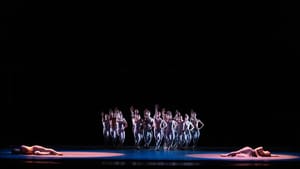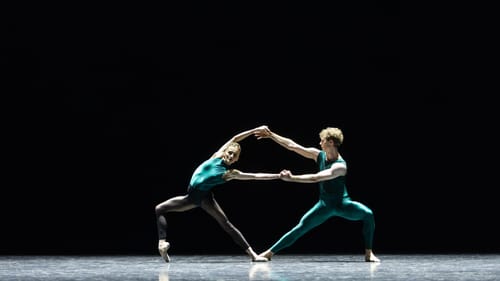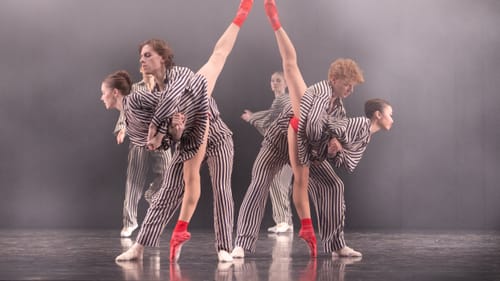Stay in the Loop
BSR publishes on a weekly schedule, with an email newsletter every Wednesday and Thursday morning. There’s no paywall, and subscribing is always free.
Three grand finales: Ailey, Forsythe, and Tharpe
Philadelphia Ballet presents Dance Masterpieces

The Philadelphia Ballet swept us along at a breakneck pace with three compelling masterpieces in the history of contemporary ballet, all set to original music that stands on its own as well. Alvin Ailey’s The River, commissioned by the American Ballet Theater in 1970 along with Duke Ellington’s symphonic suite, was the most heartfelt of the three. William Forsythe’s 1987 In the Middle, Elevated, with music by longtime collaborator Thom Willems, amazed with its speed and precarious balance. The finale, Twyla Tharpe’s In the Upper Room, brought whimsy and mystery with quirky, difficult choreography set to Philip Glass.
The river of life
Ellington viewed the course of The River as the stages of life, from the spring at its source until it reaches its end and a hope for rebirth. In “Spring,” the horns dominated the score with their sweeping, mysterious plaint while the dancers in blue unitards (by A. Christina Giannini) created the river in a line of closely matched arabesques. “Meander” was a sultry trio, with Oksana Maslova in a floating skirt leading Yuval Cohen and Pau Pujol on a merry chase. Their outstanding stretch was on display, but I liked their jazzy riffs the best.
“Falls” brought speed and male energy: Jack Sprance, Zecheng Liang, Ashton Roxander, and Federico D’Ortenzi against a red background. They pushed with their arms, contracted only to explode in kicks and leaps. “Riba” was all fun, with dancers prancing to a calypso beat and doing Rockette line kicks. Through the metaphor of the river, the piece gave us the rich emotional lives of the people who crowded its shores.
Every step a challenge
An announcement at Friday’s performance warned the audience of loud music, and the overwhelming metallic clang of Willem’s industrial music, like the heart of a factory, created a driving force that propelled Forsythe’s In the Middle, Elevated so that every step felt like a challenge.

Forsythe is an American choreographer influenced by Russian émigré George Balanchine and working in Frankfurt, Germany. He created In the Middle in 1987 for the Paris Opera Ballet just two years before the fall of the Berlin Wall. Punk and electronica were sweeping through West Germany on a wave of rebellion and, like the new styles in music, Forsythe’s choreography fractured the underlying structures of classical dance to rebuild them in compelling ways. In the Middle was originally meant as the center section of a longer postmodern ballet, Impressing the Czar. The final act would be the “sale” of a dancer, a statement about dance’s seamier past, but also a metaphor for the rigid forms of ballet, subject to the standards of a crumbling authoritarian power.
In the Middle is set in a boxing ring, the announcer’s microphone hanging in its own glow from the ceiling, and the unrelenting movement edged on violence. The three men and six women in teal and black unitards changed partners and tested each other in quick, sharp footwork and stretched moves so off-balance that they relied on a partner’s opposing low stretch as counterweight. The piece was at its dynamic best with all the dancers on stage. In a character moment as the dancers drifted offstage, Jack Thomas tapped Yuka Iseda on the shoulder, reminding her it was time to go. She brushed him off to keep dancing, and he walked away with Nayara Lopes who waited in the wings for him. Tying it all together was the precision of a foot hitting the stage to punctuate that clanging, insistent beat of the music.
Bringing the whimsy

By contrast, Twyla Tharpe’s 1988 In the Upper Room, set to Glass’s dizzying score, brought the whimsy. We were warned about the haze, and I was glad I had a mask—several patrons after the show were wishing they’d had them as well—but it worked here. Dancers in costume designer Norma Kamali’s loose black-and-white striped pants and shirts (that became hot-pink pants or tops, or bobbysoxer skirts) seemed to appear out of the dense haze and disappear into it again, often at breakneck speed, in sneakers or hot-pink pointe shoes. I loved it when three pairs crossed the stage in low formation, the women held in front of their partners, their legs crossing in a sweep over the floor. Overall, though, I wanted to like this more than I did. The dancers valiantly presented Tharpe’s loose, rolling hips and mélange of disciplines, including soft shoe in those sneakers. But there were a few problems with execution, and the dancers seemed to be flagging a bit.
The dense haze may have thrown the dancers off their game at the end, but the program was composed entirely of grand finales, as artistic director Corella describes them. Like the rest of the audience, I love these bravura displays.
What, When, Where
Dance Masterpieces. Choreography by Alvin Ailey, William Forsythe, and Twyla Tharp. Philadelphia Ballet. $22-$238 (plus a 10 percent processing fee). March 14 through 16, 2024, at the Academy of Music, 240 S Broad Street, Philadelphia. (215) 893-1999 or philadelphiaballet.org.
Accessibility
The Academy of Music is a wheelchair-accessible venue, with accessible seating locations available in advance.
Sign up for our newsletter
All of the week's new articles, all in one place. Sign up for the free weekly BSR newsletters, and don't miss a conversation.

 Camille Bacon-Smith
Camille Bacon-Smith